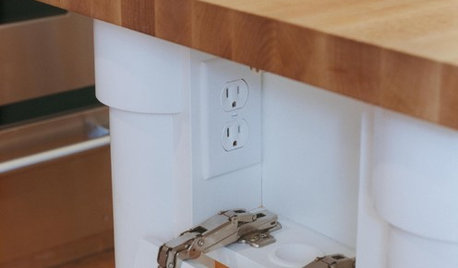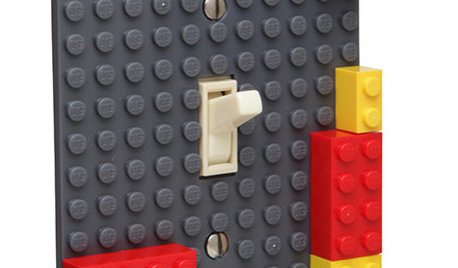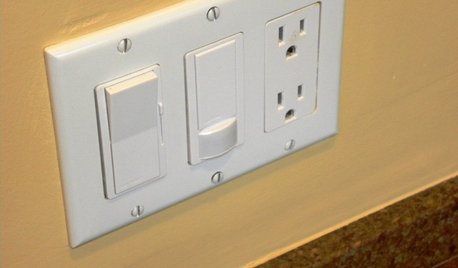Outlets & switches on a circuit
Featured Answer
Sort by:Oldest
Comments (25)
greg_2015
6 years agolast modified: 6 years agoForever Green Landscape Construction & Design thanked greg_2015Related Discussions
Power From an Outlet to a Switch and Outlets
Comments (4)Thanks for the reply. Better to run from the existing box to the first new box, then to the next, etc. If I don't put the switch in the existing outlet location (I would use a large enough box), where would it go? Of course, if this is a kitchen countertop small appliance circuit, it is a violation to tap it for lighting. It is. A two foot counter next to the fridge. So that's out. Well, there are a couple of switches about a foot or so away from that outlet that turn the dining area light and living room fan on and off. Can they be tapped for power? They seem to involve a MWBC due to a 12/3 involved. And, I've installed a third switch (3-way) at that location to operate the kitchen main light from two locations but it doesn't involve wiring from the two other switches. Make sense?...See MoreCircuit breaker - bad outlets- loose ground
Comments (1)I would attempt to fix the specific problem that you're having, and not resort to anything as drastic a replacing the wiring in your house. It sounds as though you have a significant problem with the outlet in question. Grounding wires "unhitched" would not cause the problem that you're describing. I would recommend calling an electrician to resolve your problem. Leave the circuit breaker in the off position in the meantime....See MoreReplace a wall light switch with a switch/outlet combo
Comments (12)You didn't accomplish anything by removing the break-off fin located between the black screws, and then tying them back together with wirenuts. Because it wasnt done at the power source hot. Marco, you need to think three different animals here 1. the power source 2. the three way switch circuit & lights 3. the solo outlet First task is to find the original hot. For you to keep both the 3 way switch and have a separate outlet, the outlet needs to be located in the box with the original hot OR a separate wire needs to be run to supply independent power to the outlet in the second box. The 3 way switch wiring is its own animal and cannot include the outlet if you want the outlet to not be dependent on the switches. You can't use the traveler as a constant hot unless you get rid of the 3 way. If you got rid of the 3 way, you would use black for the single light switch and red for the outlet hot....See More3 dead outlets..other outlets on same circuit work..no breaker tripped
Comments (7)I agree that a tripped GFI somewhere ahead of what you have is the most likely culprit. The challenge is to find it. Look behind furniture. Check in the cellar, especially right under or nearly under the bathroom. Look in the garage, including behind stuff. It might even be outside. When GFIs were new, they were expensive. Fairly often, a single one was daisy-chained to some or all of the other receptacles that the code said had to be protected. It's not common for a second GFI to be fed from a first, but I don't know of any harm that can cause. As for why it would be, it's possible that a previous owner didn't know the bathroom receptacle had GFI protection upstream (if it does), and added another. Another possibility is a loose connection on a receptacle that feeds the first dead one. That receptacle itself would still work if one of the downstream terminal screws were loose. Parenthetical anecdote: one of my rentals is a late 1950s tract house. I lived in it myself for a while, and during that time I did a little electrical work on it. I was astonished to find that on NONE of the original receptacles was the second set of terminal screws used. The electricans who wired the house -- and remember, this was not an expensive custom home -- actually made up soldered and taped connections in each box where there were receptacles downstream. The soldering was clean, too. No cold joints that I saw....See MoreBruce in Northern Virginia
6 years agoRon Natalie
6 years agoDavidR
6 years agoPyewacket
5 years agolast modified: 5 years agogreg_2015
5 years agoRon Natalie
5 years agolast modified: 5 years agogreg_2015
5 years agolast modified: 5 years agoDavidR
5 years agolast modified: 5 years agoPyewacket
5 years agog thom
5 years agoweedmeister
5 years agog thom
5 years agoDavidR
5 years agoweedmeister
5 years agog thom
5 years agog thom
5 years agoDavidR
5 years agolast modified: 5 years agog thom
5 years agolast modified: 5 years agoDan
5 years agoRon Natalie
5 years agog thom
5 years agolast modified: 5 years agoDavidR
5 years ago
Related Stories

DECORATING GUIDESTricks to Hide Light Switches, Outlets and Toilet Roll Holders
Embrace camouflage and other design moves to make these eyesores virtually disappear
Full Story
KITCHEN DESIGNHow to Hide Those Plugs and Switches
5 ways to camouflage your outlets — or just make them disappear
Full Story
PRODUCT PICKSGuest Picks: Bright Ideas for Fun Light Switches
Give walls a unique spin with the kookiest switch plates and outlet covers you ever did see
Full Story
LIGHTINGWhat to Know About Switching to LED Lightbulbs
If you’ve been thinking about changing over to LEDs but aren't sure how to do it and which to buy, this story is for you
Full Story
GREAT HOME PROJECTSPower to the People: Outlets Right Where You Want Them
No more crawling and craning. With outlets in furniture, drawers and cabinets, access to power has never been easier
Full Story
GREAT HOME PROJECTSHow to Install a Dimmer Switch
New project for a new year: Take control of your lighting to set the right mood for entertaining, dining and work
Full Story
DECORATING GUIDESHomeowners Are Flipping for Push-Button Light Switches
Button-style switches are hot off the presses again, making news in new homes and antique remodels
Full Story
GREAT HOME PROJECTSHow to Switch to a Tankless Water Heater
New project for a new year: Swap your conventional heater for an energy-saving model — and don’t be fooled by misinformation
Full Story
REMODELING GUIDESBanish Gizmo Blemishes on Your Walls
Unsightly switches, vents and outlets can ruin your interior design's clear complexion. Keep the look pure with an architect's tips
Full Story
ACCESSORIES8 Low-Cost Luxuries With a Big Payoff
Consider the small stuff — like switch plates and throw pillows — to give your home a touch of class
Full Story




greg_2015